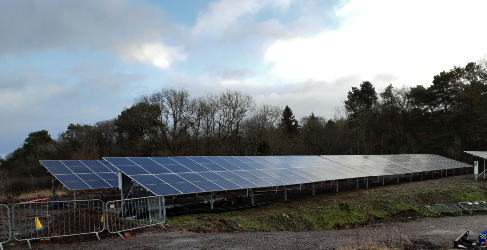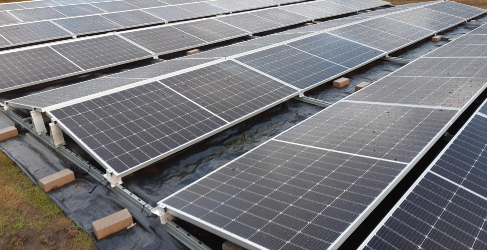Self Generating Skellyton Now Online
20 January 2023
Photovoltaic panels at Skellyton

They will generate over 150MWh per year
A Scottish Water treatment works in South Lanarkshire is partially powering itself thanks to green energy.
An array of 560 solar photovoltaic (PV) panels at Skellyton near Larkhall is now online producing more than 20 per cent of the electricity needed to operate the facility.
Generating over 150MWh each year the carbon-reducing technology will also contribute around 12 per cent of the generated electricity to the national grid.
The green energy boost follows a £200,000 investment by the public utility’s commercial subsidiary, Scottish Water Horizons, helping to lower the carbon footprint of water supplies to surrounding areas.
Local Waste Water Treatment Works Team Leader Stevie Heatley said: “We are now generating the same amount of energy needed to boil a kettle 1.5 million times or watch a million hours of television.
“The new installation will help us achieve a cut in carbon dioxide emissions associated with Skellyton by over 20 tonnes a year and sets us on the path to energy self-sufficiency.”
Installed by Scotland-based company, Absolute Solar and Wind, the PV panels have been positioned in an area of scrub, brownfield land within the boundaries of the existing works.
Ian Piggott, Senior Project Manager at Scottish Water Horizons, said: “This project is the latest in a long list of renewables schemes already installed at many treatment works and other Scottish Water assets across Scotland.
“Energy self-sufficiency is a key component in our strategy to achieve net zero carbon emissions by 2040 and has the added benefit of exporting electricity to help offset carbon emissions further afield.”
As well as committing to net zero by 2040 Scottish Water has set an interim target to host or self-generate three times its annual electricity consumption by 2030.
Almost 80 of the company’s water and waste water treatment works are now either self-sufficient or partly sufficient in their power requirements.
The programme of energy self-sufficiency projects is in line with the recently launched Scottish Government Draft Energy Strategy and Just Transition Plan. It includes an ambition for the generation of surplus electricity, enabling export of electricity and renewable hydrogen to support decarbonisation across Europe
An array of 560 solar photovoltaic (PV) panels at Skellyton near Larkhall is now online producing more than 20 per cent of the electricity needed to operate the facility.
Generating over 150MWh each year the carbon-reducing technology will also contribute around 12 per cent of the generated electricity to the national grid.
The green energy boost follows a £200,000 investment by the public utility’s commercial subsidiary, Scottish Water Horizons, helping to lower the carbon footprint of water supplies to surrounding areas.
Local Waste Water Treatment Works Team Leader Stevie Heatley said: “We are now generating the same amount of energy needed to boil a kettle 1.5 million times or watch a million hours of television.
“The new installation will help us achieve a cut in carbon dioxide emissions associated with Skellyton by over 20 tonnes a year and sets us on the path to energy self-sufficiency.”
Installed by Scotland-based company, Absolute Solar and Wind, the PV panels have been positioned in an area of scrub, brownfield land within the boundaries of the existing works.
Ian Piggott, Senior Project Manager at Scottish Water Horizons, said: “This project is the latest in a long list of renewables schemes already installed at many treatment works and other Scottish Water assets across Scotland.
“Energy self-sufficiency is a key component in our strategy to achieve net zero carbon emissions by 2040 and has the added benefit of exporting electricity to help offset carbon emissions further afield.”
As well as committing to net zero by 2040 Scottish Water has set an interim target to host or self-generate three times its annual electricity consumption by 2030.
Almost 80 of the company’s water and waste water treatment works are now either self-sufficient or partly sufficient in their power requirements.
The programme of energy self-sufficiency projects is in line with the recently launched Scottish Government Draft Energy Strategy and Just Transition Plan. It includes an ambition for the generation of surplus electricity, enabling export of electricity and renewable hydrogen to support decarbonisation across Europe







